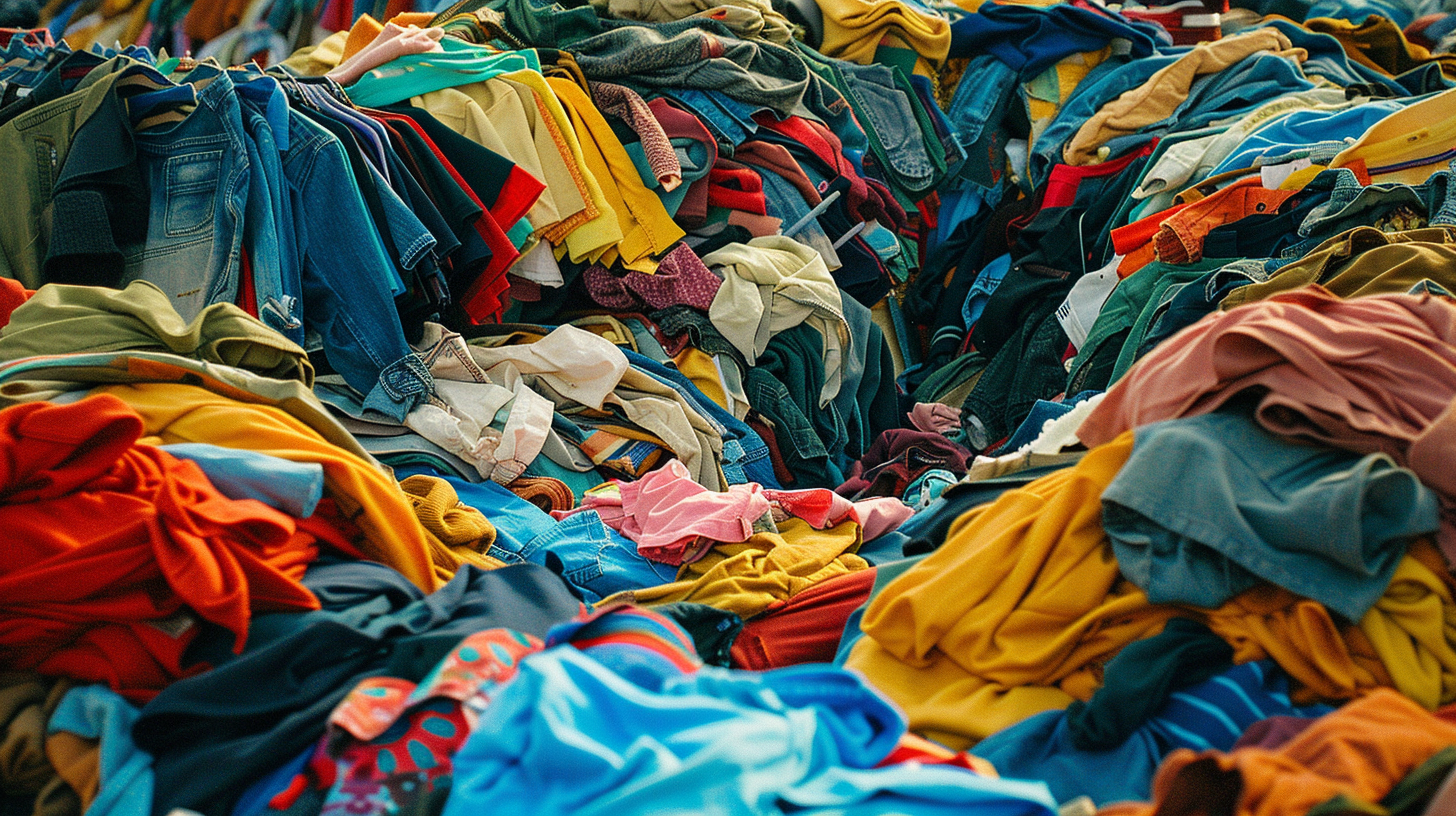Table of Contents Show
There may be products. Products are independently selected by our editors. We may earn an affiliate commission from the links with no charge to you, example: as Amazon Affiliate.
I’ve decided to opt out of fast fashion after witnessing the harmful effects it has on the environment and the people who make our clothes. The massive water pollution from dyeing processes and the exploitative labor practices in factories are clear indicators of the true cost of cheap clothing. The impact goes beyond what meets the eye, and there are sustainable alternatives that prioritize ethical production methods and environmental responsibility. If you’re curious about sustainable fashion choices and how they can make a difference, there’s a lot more to discover.
Key Takeaways
- Fast fashion harms the environment through pollution.
- Exploitative labor practices are rampant in the industry.
- Cheap clothing contributes to overflowing landfills.
- Health risks stem from chemicals in manufacturing processes.
- Sustainable fashion offers ethical and eco-friendly alternatives.
The Environmental Impact of Fast Fashion
The fast fashion industry relentlessly churns out trendy clothing, leaving a destructive environmental footprint. As a consumer, it’s easy to get caught up in the allure of cheap and fashionable clothing without considering the consequences. However, the reality is that this industry is one of the largest polluters globally, second only to the oil industry.
The production of fast fashion involves immense water usage, with millions of tons of water contaminated by toxic chemicals from dyeing processes ending up in rivers and oceans each year. Additionally, the carbon footprint of fast fashion is substantial, with the transportation of garments across the globe contributing to greenhouse gas emissions.
The environmental impact of fast fashion extends beyond production. The throwaway culture it promotes results in vast amounts of textile waste ending up in landfills. These synthetic fabrics can take hundreds of years to decompose, further exacerbating environmental problems. It’s crucial to recognize the true cost of cheap clothing and consider more sustainable alternatives to lessen the environmental burden imposed by fast fashion.
Ethical Concerns in Clothing Production
When we think about the ethical concerns in clothing production, two major issues come to mind: labor exploitation and environmental impact.
The harsh reality of sweatshops and poor working conditions in garment factories is a prevalent concern, often overlooked in the pursuit of cheap clothing.
Additionally, the massive carbon footprint and waste generated by fast fashion contribute to environmental degradation, raising questions about the industry’s sustainability practices.
Labor Exploitation
Amidst the allure of trendy, budget-friendly clothing lies a dark reality of exploitation in the garment industry. Workers, often in developing countries, endure long hours, unsafe working conditions, and meager wages to produce the cheap garments that fill fast fashion stores.
The pressure to meet demanding production quotas leads to labor exploitation, with workers facing verbal abuse, inadequate breaks, and little job security. Many garment workers are denied basic human rights, such as the freedom to unionize or fair compensation for their labor.
As consumers, we must recognize the human cost behind our inexpensive clothing choices and advocate for fair treatment and ethical practices in the fashion industry.
Environmental Impact
Considering the environmental impact of clothing production is imperative in understanding the full scope of ethical concerns within the fashion industry. Fast fashion’s toll on the environment is significant due to excessive water usage, chemical pollution, and textile waste.
Personally, I find it troubling that:
- The fashion industry is the second-largest consumer of water worldwide.
- Synthetic fibers release microplastics into oceans when washed.
- Pesticides and dyes from clothing production contaminate water sources.
- Landfills are filled with non-biodegradable clothing.
- Carbon emissions from transportation contribute to climate change.
Social Ramifications of Fast Fashion
Participating in the fast fashion industry not only fuels a cycle of overconsumption but also perpetuates exploitative labor practices worldwide. The pressure to produce clothing quickly and cheaply leads to garment workers, often in developing countries, enduring unsafe working conditions, long hours, and meager wages. This exploitation is further exacerbated by the lack of transparency within the supply chain, making it difficult for consumers to trace where and how their clothes are made.
Moreover, the fast fashion model promotes a culture of disposability, where clothing is seen as almost disposable items, leading to a devaluation of the craftsmanship and artistry involved in creating garments. This mindset not only impacts the workers who make the clothes but also influences consumers to view fashion as something temporary and easily replaceable.
Hidden Costs of Cheap Clothing
Unveiling the true costs of cheap clothing reveals the hidden toll on both the environment and human well-being. When we purchase inexpensive garments, we often overlook the detrimental consequences associated with their production and disposal:
-
Environmental Pollution: Fast fashion leads to increased water pollution through dyeing and chemical processes, contributing to the contamination of rivers and oceans.
-
Exploitative Labor Practices: Cheap clothing is frequently produced in factories with poor working conditions, low wages, and long hours, exploiting vulnerable workers in developing countries.
-
Landfill Overflow: The disposal of cheap clothing adds to the already overflowing landfills, as synthetic fibers take hundreds of years to decompose.
-
Health Impacts: The chemicals used in manufacturing cheap clothing can have adverse health effects on both workers and consumers, leading to respiratory issues and skin irritations.
-
Resource Depletion: The mass production of cheap clothing depletes non-renewable resources like water and fossil fuels, further exacerbating environmental degradation.
Sustainable Fashion Alternatives
I’ll start by highlighting the importance of eco-friendly fabric options, fair trade practices, and ethical production methods in sustainable fashion alternatives. Making conscious choices in these areas not only benefits the environment but also supports ethical labor practices.
Embracing these aspects can lead to a wardrobe that aligns with personal values and promotes a more sustainable future.
Eco-Friendly Fabric Options
Exploring eco-friendly fabric options offers a sustainable approach to fashion, aligning with ethical and environmental values. Opting for these materials not only reduces the negative impact on the planet but also supports responsible consumption habits.
Some eco-friendly fabric options to consider include:
- Organic Cotton: Grown without harmful pesticides.
- Hemp: Requires minimal water and no pesticides to grow.
- Tencel (Lyocell): Made from sustainably sourced wood pulp.
- Bamboo: Fast-growing and biodegradable.
- Recycled Polyester: Reduces the need for new petroleum-based fibers.
Choosing clothing made from these eco-friendly fabrics can help promote a more sustainable fashion industry.
Fair Trade Practices
Fair trade practices in the fashion industry offer sustainable alternatives that prioritize ethical production and support workers’ rights. By choosing to support brands that adhere to fair trade principles, I’m ensuring that the individuals involved in crafting the clothes I wear are treated fairly and paid a living wage.
This means that no one along the supply chain is exploited for the sake of cheap fashion. Fair trade practices also promote transparency, allowing consumers to trace the origins of their clothing and guaranteeing that no child labor or unsafe working conditions were involved.
Making a conscious decision to opt for fair trade fashion empowers me to contribute to a more ethical and sustainable industry while supporting the well-being of workers worldwide.
Ethical Production Methods
Opting for brands that prioritize ethical production methods ensures a more sustainable fashion choice. By supporting companies that value ethical production, we contribute to a healthier planet and better working conditions for garment workers. Ethical production methods encompass various practices that prioritize both environmental and social responsibility:
- Use of eco-friendly materials such as organic cotton and recycled fabrics
- Fair wages and safe working conditions for workers
- Transparent supply chains to ensure accountability
- Minimal waste through efficient production processes
- Support for artisanal craftsmanship and traditional techniques
Choosing ethically produced clothing not only benefits the environment and workers but also promotes a more conscious approach to fashion consumption.
Embracing Long-lasting Style
In my wardrobe, I prioritize pieces that stand the test of time, opting for quality over quantity. Investing in timeless styles and high-quality garments not only ensures longevity but also reduces the constant need to replace worn-out items. Embracing long-lasting style means selecting versatile pieces that can be mixed and matched to create a variety of looks, saving both money and closet space.
By focusing on durability and classic designs, I aim to build a collection of clothing that transcends fleeting trends. Timeless pieces such as a well-tailored blazer, a crisp white shirt, and a little black dress never go out of style and can be worn year after year without losing their appeal. Embracing long-lasting style also involves caring for garments properly, following care instructions, and repairing items when needed to prolong their lifespan.
Ultimately, embracing long-lasting style isn’t just about fashion; it’s a mindset shift towards sustainable consumption and a more conscious approach to dressing that values quality, longevity, and personal style over fast-paced trends.
Frequently Asked Questions
What Are Some Specific Ways That Fast Fashion Contributes to Water Pollution and Waste?
Fast fashion contributes to water pollution and waste through dyeing processes, excessive water usage, and the disposal of unsold garments. These practices harm ecosystems, contaminate water sources, and generate immense textile waste.
How Do Clothing Production Workers in Developing Countries Typically Experience Exploitation and Unsafe Working Conditions?
Working in developing countries, clothing production workers often face exploitation and unsafe conditions. Shockingly, 98% of these workers in Bangladesh’s garment factories reported experiencing verbal abuse or harassment, highlighting the dire need for change.
Can You Provide Examples of How Fast Fashion Perpetuates Societal Pressure to Constantly Consume and Discard Clothing?
Fast fashion constantly bombards us with new trends, making us feel the need to buy more and discard perfectly good clothing. This pressure to consume fuels a cycle of waste and contributes to environmental and social issues.
What Are Some Lesser-Known Environmental Costs Associated With the Production and Disposal of Cheap Clothing?
Producing and disposing of cheap clothing harms ecosystems through toxic chemical pollution, water waste, and greenhouse gas emissions. These environmental costs are often overlooked but have far-reaching impacts on our planet’s health and sustainability.
How Can Individuals Support Sustainable Fashion Alternatives Without Breaking the Bank?
I support sustainable fashion by shopping secondhand, renting clothes, and investing in quality pieces that last. It’s about making conscious choices and prioritizing ethical brands. By being mindful of my purchases, I can contribute to a more sustainable fashion industry.
Conclusion
As I bid farewell to fast fashion, I realize the true cost of cheap clothing goes far beyond my wallet. The environmental damage, unethical practices, and social impact are too high a price to pay.
So, I choose to opt out and embrace sustainable fashion alternatives. Who knew that looking good could actually be good for the planet and people too?
It’s ironic how the pursuit of style can lead to a more ethical wardrobe.









